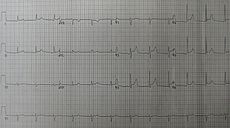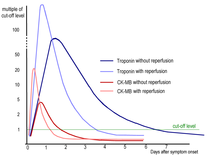Pericarditis
| Pericarditis | |
|---|---|
| Classification and external resources | |

An ECG showing pericarditis. Note the ST elevation in multiple leads
|
Pericarditis is an inflammation of the pericardium (the fibrous sac surrounding the heart). A characteristic chest pain is often present.
The causes of pericarditis are varied, including infections of the pericardium by viruses or bacteria (e.g., Mycobacterium tuberculosis), idiopathic causes, uremic pericarditis, post-infarct pericarditis (within 24 hours of a heart attack), or Dressler's syndrome (weeks to months after a heart attack).
Classification
Types of pericarditis include the following:
Acute vs. chronic
Depending on the time of presentation and duration, pericarditis is divided into "acute" and "chronic" forms. Acute pericarditis is more common than chronic pericarditis, and can occur as a complication of infections, immunologic conditions, or even as a result of a heart attack (myocardial infarction). Chronic pericarditis however is less common, a form of which is constrictive pericarditis. The following is the clinical classification of acute vs. chronic:
- Clinically: Acute (<6 weeks), Subacute (6 weeks to 6 months) and Chronic (>6 months)
Signs and symptoms
Substernal or left precordial pleuritic chest pain with radiation to the trapezius ridge (the bottom portion of scapula on the back), which is relieved by sitting up and bending forward and worsened by lying down (recumbent or supine position) or inspiration (taking a breath in), is the characteristic pain of pericarditis.[2] The pain may resemble the pain of angina pectoris or heart attack, but differs in that pain changes with body position, as opposed to heart attack pain that is pressure-like, and constant with radiation to the left arm and/or the jaw. Other symptoms of pericarditis may include dry cough, fever, fatigue, and anxiety. Due to similarity to myocardial infarction (heart attack) pain, pericarditis can be misdiagnosed as an acute myocardial infarction (a heart attack) solely based on the clinical data and so extreme suspicion on the part of the diagnostician is required. Acutemyocardial infarction (heart attack) can also cause pericarditis, but the presenting symptoms often differ enough to warrant diagnosis. The following table organizes the clinical presentation of pericarditis:[2]
| Characteristic/Parameter | Pericarditis | Myocardial infarction |
|---|---|---|
| Pain description | Sharp, pleuritic, retro-sternal (under the sternum) or left precordial (left chest) pain | Crushing, pressure-like, heavy pain. Described as "elephant on the chest." |
| Radiation | Pain radiates to the trapezius ridge (to the lowest portion of the scapula on the back) or no radiation. | Pain radiates to the jaw, or the left or arm, or does not radiate. |
| Exertion | Does not change the pain | Can increase the pain |
| Position | Pain is worse in the supine position or upon inspiration (breathing in) | Not positional |
| Onset/duration | Sudden pain, that lasts for hours or sometimes days before a patient comes to the ER | Sudden or chronically worsening pain that can come and go in paroxysms or it can last for hours before the patient decides to come to the ER |
Physical examinations
The classic sign of pericarditis is a friction rub heard with a stethoscope on the cardiovascular examination usually on the lower left sternal border.[2] Other physical signs include a patient in distress, positional chest pain, diaphoresis (excessive sweating), and possibility of heart failure in form of precardial tamponade causing pulsus paradoxus, and theBeck's triad of low blood pressure (due to decreased cardiac output), distant (muffled) heart sounds, and distension of the jugular vein (JVD).
Acute complications
Pericarditis can progress to pericardial effusion and eventually cardiac tamponade. This can be seen in patients who are experiencing the classic signs of pericarditis but then show signs of relief, and progress to show signs of cardiac tamponade which include decreased alertness and lethargy, pulsus paradoxus (decrease of at least 10 mmHg of the systolic blood pressure upon inspiration),low blood pressure (due to decreased cardiac index), (jugular vein distention from right sided heart failure and fluid overload), distant heart sounds on auscultation, and equilibration of all the diastolic blood pressures on cardiac catheterization due to the constriction of the pericardium by the fluid.
In such cases of cardiac tamponade, EKG or Holter monitor will then depict electrical alternans indicating wobbling of the heart in the fluid filled pericardium, and the capillary refillmight decrease, as well as severe vascular collapse and altered mental status due to hypoperfusion of body organs by a heart that can not pump out blood effectively.
The diagnostic test for cardiac tamponade, is trans-esophageal echocardiography (TEE) although trans-thoracic echocardiography (TTE) can also be utilized in cases where there is a high suspicion of aortic dissection and high blood pressure, or in patients where esophageal probing is not feasible. Chest X-ray can depict a "water bottle" appearance of the heart in tamponade, although chest X-ray is neither specific enough nor accurate enough in the acute setting.[citation needed] Of note is the fact that chest x-ray can be entirely normal in acute pericardial effusion/tamponade and therefore should not be relied upon as the sole diagnostic tool.[citation needed]
Causes
Infectious
Pericarditis may be caused by viral, bacterial, or fungal infection. The most common viral pathogen has traditionally been considered to be coxsackievirus based on studies in children from the 1960s, but recent data suggest that adults are most commonly affected with cytomegalovirus, herpesvirus, and HIV.[3][4] Pneumococcus or tuberculous pericarditis are the most common bacterial forms. Anaerobic bacteria can also be a rare cause.[5] Fungal pericarditis is usually due to histoplasmosis, or in immunocompromisedhosts Aspergillus, Candida, and Coccidioides.[citation needed] The most common cause of pericarditis worldwide is infectious pericarditis with Tuberculosis.[citation needed]
Other
| By Dr Sherazi clinic staff |
- Idiopathic: No identifiable etiology found after routine testing.
- Immunologic conditions including systemic lupus erythematosus (more common among women) or rheumatic fever
- Myocardial infarction (Dressler's syndrome)
- Trauma to the heart, e.g. puncture, resulting in infection or inflammation
- Uremia (uremic pericarditis)
- Malignancy (as a paraneoplastic phenomenon)
- Side effect of some medications, e.g. isoniazid, cyclosporine, hydralazine, warfarin, and heparin
- Radiation induced
- Aortic dissection
- Tetracyclines
- Postpericardiotomy syndrome: Usually after CABG surgery
Diagnosis
Laboratory tests
Laboratory values can show increased urea (BUN), or increased blood creatinine in cases of uremic pericarditis. Generally however, laboratory values are normal, but if there is a concurrent myocardial infarction (heart attack) or great stress to the heart, laboratory values may show increased cardiac markers like Troponin (I, T), CK-MB, Myoglobin, and LDH1 (Lactase Dehydrogenase isotype 1). The preferred initial diagnostic testing is the EKG which will show a 12-lead electrocardiogram with diffuse, non-specific, concave, ST segment-elevations all leads except aVR and V1[2] and PR segment-depression possible in any lead except aVR;[2] sinus tachycardia, and low-voltage QRS complexes can also be seen if there is subsymptomatic levels of pericardial effusion. The PR depression is often seen early in the process as the thin atria are affected more easily than the ventricles by the inflammatory process of the pericardium.
Since the mid-19th Century, retrospective diagnosis of pericarditis has been made upon the finding of adhesions of the pericardium.[6]When pericarditis is diagnosed clinically, the underlying cause is often never known; it may be discovered in only 16-22 percent of patients with acute pericarditis.[citation needed]
Imaging
Treatment
The treatment in viral or idiopathic pericarditis is with aspirin,[2] or non-steroidal anti-inflammatory drugs (NSAIDs such as ibuprofen).[7] Colchicine may be added to the above.[7]Severe cases may require one or more of the following:
- pericardiocentesis to treat pericardial effusion/tamponade
- antibiotics to treat tuberculosis or other bacterial causes.
- steroids are used in acute pericarditis but are not favored because they increase the chance of recurrent pericarditis.
- in rare cases, surgery
- in cases of constrictive pericarditis, pericardiectomy







.jpg)

.jpg)
.jpg)
.jpg)
.jpg)
.jpg)
.jpg)
.jpg)



.jpg)


No comments:
Post a Comment